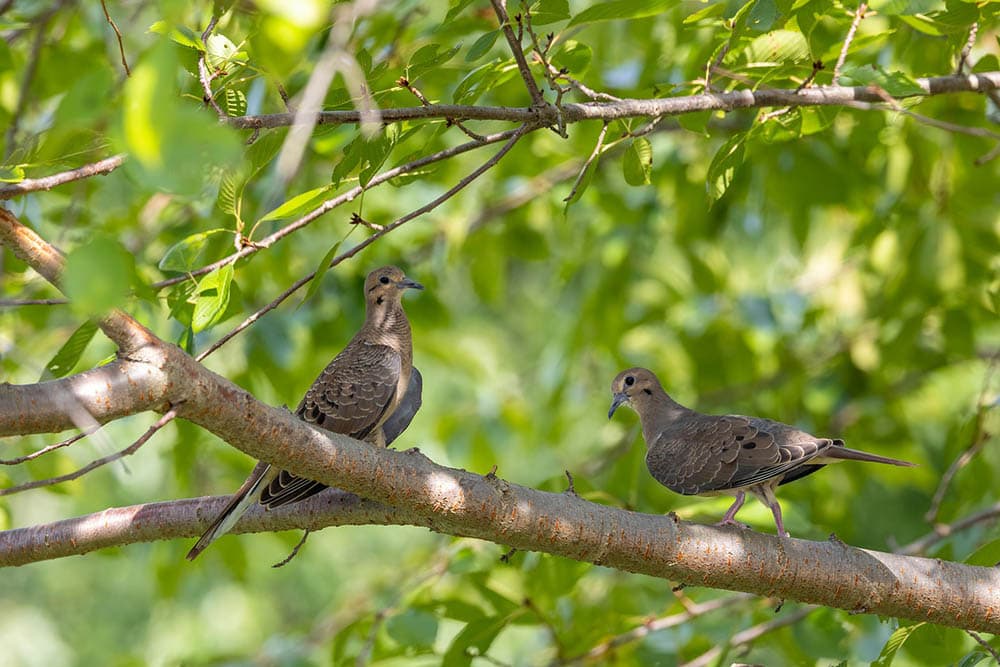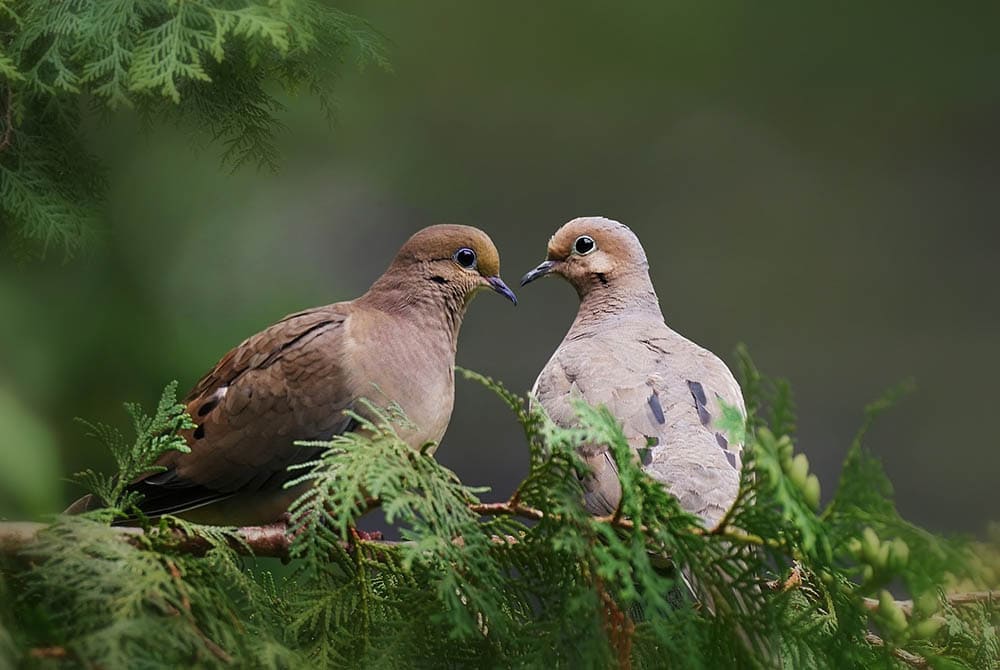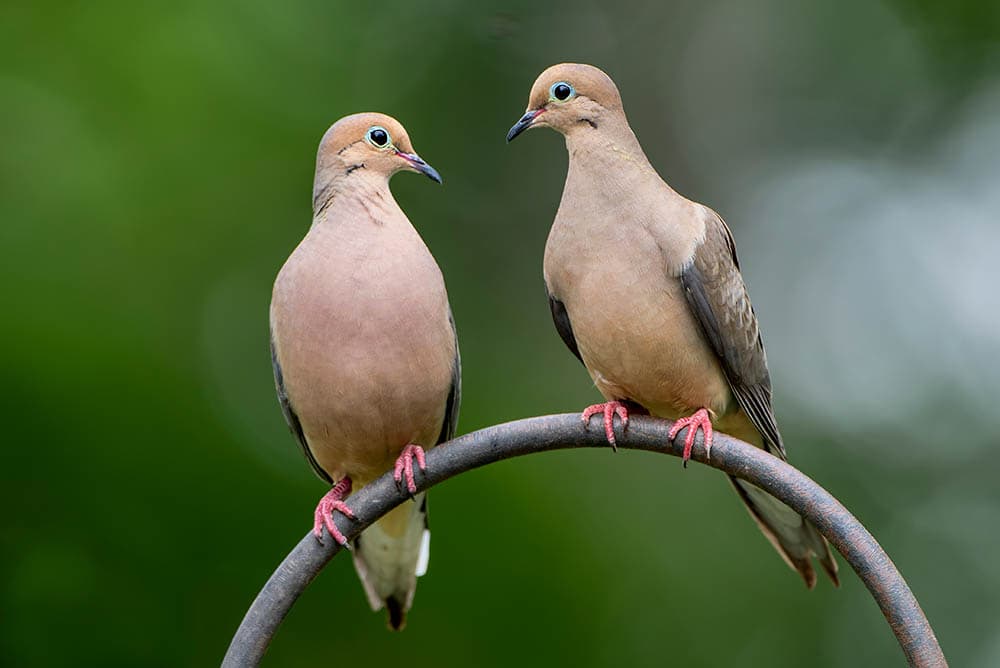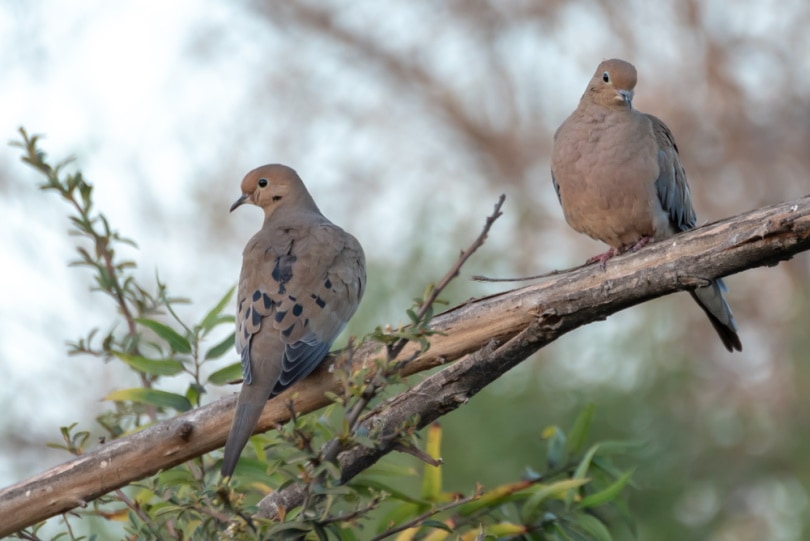Do Mourning Doves Mate for Life? What You Need to Know!
Last Updated on

The Mourning doves belong to the Columbidae family, which consists of pigeons and several dove species. They are one of the most widespread birds in North and Central America. People usually know Mourning doves for their prolific breeding style.
You’ll be surprised that these birds nurture three or four broods yearly. In fact, this figure could go up to six broods a year! So, is it true that Mourning doves mate for life? Typically, Mourning doves are seasonally monogamous. These birds pair with new doves every breeding season. Not just that, but many birds reform their bond with the same partner. Mourning doves stay loyal to each other during the breeding season and spend most of their time together. Some even stay together throughout the year in warmer regions, which may stretch to mating for life.1
Mourning doves don’t shy away from showing affection to their mate. You’ll often find them cuddling and preening each other. But, if you’re a keen observer, you may also hear a gentle coo. That’s the way for Mourning birds to greet their partner.
Let’s learn more about the mating behaviors of Mourning doves.

What Is the Mating Behavior of Mourning Doves?
Just when the breeding season comes close, the male Mourning doves begin to settle near females. In many parts of North America, these doves start to search for their mates ahead of the breeding season. It usually begins in early October and goes through February.
Mourning birds stay in the same relationship the entire year in warmer regions. This may count as mating for life. Typically, non-migratory Mourning doves develop lifelong bonds with a single bird, as they prefer to stay in the same area their entire life.

How Do Mourning Doves Invite a Mate?
The mating process of Mourning doves can get pretty aggressive. While inviting females for mating, male Mourning doves can be violent towards each other.
Females listen to the “cooing” sound made by the males and know that they are invited. Most male Mourning doves also perch around females the entire day to lure them in. Some males even gather the courage to sit closer to the female or fly straight to their perch.
If you head to the Mourning Dove’s habitat during the breeding season, you may also observe aerial displays of mating. This involves the male flapping their wings and flying up and down passionately.
Wing clapping or flapping is the most common way for male Mourning doves to attract a female for mating. When the female is finally lured in, the male starts to preen for them. The same goes for the females, who groom the male in return.
During the courtship bonding, both partners may vibrate their wings, displaying love and pleasure.
Mourning doves also bill and spend their entire day sitting and cooing together. Once the female is ready for mating, she bows her head in agreement. Then, the male mounts her. After copulation, doves groom and preen at each other for some time.
How Do a Mourning Dove Pair Build Nests?
Mourning doves are pretty cooperative with their partners. They usually do everything together, from searching for food to building the nest and nurturing their chicks. When Mourning doves form a pair, the male searches for a strong and suitable nesting site.
Mourning doves usually nest anywhere. But the best places for nesting in wild or rural areas are in dense or woodland vegetation, usually in a medium tree. These birds typically nest in trees, ledges, and bushes and rarely on the ground.
In the early nesting season, Mourning doves prefer settling within the conifer covers. After the deciduous leaf-out, they fly to different trees for their nests, such as cottonwoods and oaks. The distance of their nests from the ground varies a lot. It could be on the ground level or as high as 200 feet.
Once the nesting site is decided, the male scouts for small twigs and brings them to the females for nest construction. Their successful breeding behavior is because they don’t spend much time enhancing their nests. Instead, they prefer making them the easiest way.
The nest of Mourning doves has a simple bowl-shaped structure consisting of small twigs. Their nests are usually situated in the crook of a tree, but some doves may also build their nests on top of abandoned nests.

Do Both Mourning Dove Partners Incubate Their Eggs?
Male Mourning doves cooperate with their partners in the incubation process too. Not only females, but males also are a part of the incubation period. Both partners take turns, usually during a 24-hour period.
The male incubates the eggs from morning till late afternoon or when the female returns from the whole day of scouting. However, some pairs only prefer females to be in charge of the entire 24-hour incubation.
The incubation duration of Mourning doves’ eggs is typically 14 days. It could be fewer days in warmer regions. When a Mourning dove pair wants to exchange their nests, both partners start cooing gently.
Do Mourning Doves Help Each Other Raise the Chicks?
Both Mourning doves collaborate with each in raising their chicks. As a result, these birds establish firmer bonds with their partners, which shows their excellent teamwork.
As soon as the chicks hatch from the eggs, both partners ensure the warmth of their kids. The brooding behavior of Mourning doves is similar to their incubation style. The male takes care of the chicks from the morning until the afternoon. Females cover the entire evening till morning. The brooding pattern of Mourning doves may vary depending on the weather.
Once the babies are born, the Mourning dove couple feeds them with a protein and fat-rich liquid known as crop milk. It is like mammalian milk that most pigeons and doves give their chicks for nourishment.

Both Mourning dove partners team up to feed crop milk to their chicks. This routine continues for almost a week. After that, the parents try to provide harder meals to their chicks, such as insects, seeds, grains, and berries.
Mourning doves start preparing for the next brood after about ten days of nourishing their existing offspring. At this time, males take the responsibility of feeding, enabling the females to prepare themselves for the next brood.
These doves share all the duties, which is the primary factor behind their quick and efficient breeding. This is why they are one of America’s most successful and widespread birds.

Conclusion
Mourning doves are one of the prevalent birds in North and Central America. These birds are famous for their breeding behaviors. A Mourning bird pair always works in collaboration to build nests, incubate eggs, and nurture their chicks.
While some of these birds find a new partner in every breeding season, others repair with their old mates. Once the bond forms, Mourning doves stay loyal throughout the breeding season. Some pairs even remain together the entire year in warmer regions for a lifetime.
Mourning doves don’t usually mourn their deceased partners. Instead, they move on and search for a new partner before the next breeding season.
Featured Image Credit: MOHANN, Pixabay
About the Author Jeff Weishaupt
Jeff is a tech professional by day, writer, and amateur photographer by night. He's had the privilege of leading software teams for startups to the Fortune 100 over the past two decades. He currently works in the data privacy space. Jeff's amateur photography interests started in 2008 when he got his first DSLR camera, the Canon Rebel. Since then, he's taken tens of thousands of photos. His favorite handheld camera these days is his Google Pixel 6 XL. He loves taking photos of nature and his kids. In 2016, he bought his first drone, the Mavic Pro. Taking photos from the air is an amazing perspective, and he loves to take his drone while traveling.
Related Articles:
10 Types of Hummingbirds in Arkansas (With Pictures)
8 Types of Hummingbirds in Nebraska (With Pictures)
5 Types of Hummingbirds in Idaho (With Pictures)
3 Types of Hummingbirds in Mississippi (With Pictures)
8 Types of Hummingbirds in Kansas (With Pictures)
5 Types of Hummingbirds in West Virginia (With Pictures)
5 Types of Hummingbirds in Ohio (With Pictures)
Where Do Nuthatches Nest? Nuthatch Nesting Habits Explained
